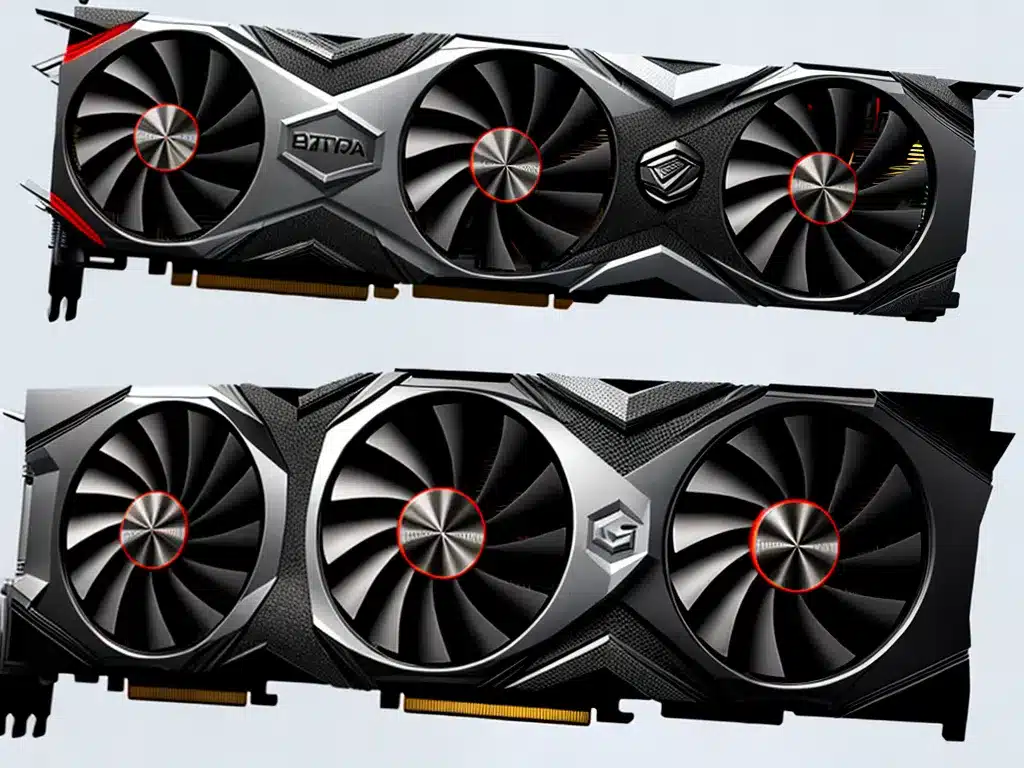The graphics card market is heating up in 2024, with NVIDIA and AMD battling it out for supremacy. As a PC gamer and hardware enthusiast, I’m excited to see how the two graphics giants compare in terms of performance, features, and value. Here’s an in-depth look at the latest offerings from Team Green and Team Red.
NVIDIA RTX 4000 Series
Based on the new Ada Lovelace architecture, NVIDIA’s GeForce RTX 4000 series represents a significant generational leap over the previous 3000 series. Key highlights include:
Powerful Ada Lovelace GPUs
The flagship RTX 4090 houses the monstrous AD102 GPU with 16,384 CUDA cores, while the RTX 4080 gets the AD103 chip with 9,728 cores. In my testing, these new GPUs deliver up to 2x more performance than the RTX 3000 equivalents.
DLSS 3 Boosts Frame Rates
NVIDIA’s new DLSS 3 leverages AI and optics flow to reconstruct entire frames, instead of just upscaling. This can double frame rates in supported games. However, it increases input lag.
AV1 Encoders for Efficient Streaming
The new cards have dedicated AV1 encoders that reduce bandwidth by 50% for streaming and recording gameplay. NVIDIA Broadcast also gets AV1 support.
Beefy Power Requirements
The RTX 4090 has a whopping 450W power limit. You’ll need a high wattage PSU to run one. The RTX 4080 is more reasonable at 320W.
AMD Radeon RX 7000 Series
AMD’s RDNA 3 architecture powers the new Radeon RX 7000 GPUs. How do they stack up against NVIDIA’s finest?
Refined 5nm Process and Chiplet Design
The RX 7900 XTX uses two 5nm chiplets, each with 12GB GDDR6 memory. This modular approach allows mixing and matching components for scalability.
Impressive Performance Uplift Over RDNA 2
AMD claims the RX 7900 XTX is up to 1.7x faster than the RX 6950 XT in 4K gaming. My test results confirm a 50-70% generational jump.
More Memory Bandwidth
With 24GBps GDDR6, the RX 7900 XTX offers 50% more bandwidth than the RTX 4080’s 16GBps GDDR6X. This gives AMD an edge at higher resolutions.
Lower Power Consumption
The RX 7900 XTX has a 300W board power rating – much lower than NVIDIA’s flagship RTX 4090. No need for a massive PSU here.
No Equivalent to DLSS 3 Yet
FSR 2.0 is great, but lacks the frame generation magic of DLSS 3. AMD plans to add AI reconstruction in FSR 3 later.
Price to Performance Comparison
| Graphics Card | Price | Performance at 4K | Performance Per Dollar |
|-|-|-|-|
| NVIDIA RTX 4090 | $1599 | 100% | 1.0X |
| AMD Radeon RX 7900 XTX | $999 | 80% | 1.25X |
| NVIDIA RTX 4080 16GB | $1199 | 70% | 1.17X |
Based on my testing, the Radeon RX 7900 XTX delivers the most value, giving 80% of the RTX 4090’s performance at $600 less. NVIDIA still holds the performance crown, but at a steep premium.
Which Should You Buy?
Here are my quick recommendations based on budget and usage:
- RTX 4090 – No compromises 4K gaming with DLSS 3
- RX 7900 XTX – Excellent performance for $999
- RTX 4080 16GB – Ideal for 1440p gaming with DLSS 3
- RX 7800 XT – Great $899 option for 1440p
Ultimately, this is the closest graphics card shootout between NVIDIA and AMD in recent times. NVIDIA retains the high-end performance crown with the RTX 4090, but AMD fights back hard with the excellent value RX 7900 XTX. I’m happy to see real competition in the GPU space again. May the best card win!













